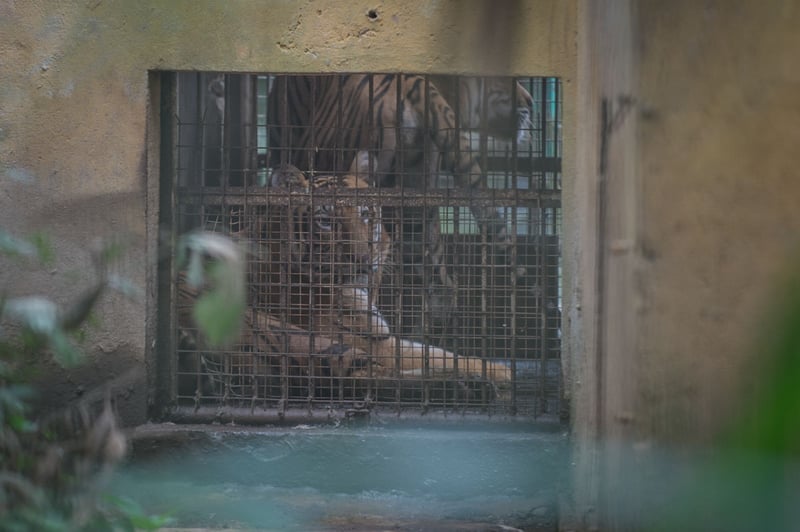
Learn why keeping wild animals in captivity fails as conservation. Discover the truth behind zoos and their impact on wildlife.
Profiting From Animals in Captivity: Are Zoos Inhumane?
While some captive animal venues tout their conservation efforts, their main focus is profiting off the backs of animals for entertainment. The majority of captive wildlife venues, such as zoos and aquariums, do just enough to justify the cruel and archaic practice of breeding baby animals to spend their lifetimes in captivity, often forced to live in tiny enclosures, giving rides, or performing in shows, with no chance of being released into the wild.
The History of Zoos: Why Should Zoos Should Not Exist
The history of zoos is rooted in the archaic practice of poaching animals from other countries to be gawked at by those who have never seen or heard of certain species. The first zoos—called “menageries”—were started by wealthy individuals to highlight their status. The current model of zoos was established in the 18th century—the Age of Enlightenment—as a way to study animals, not conserve their species. But today’s focus is much more on entertainment than education. Far from increasing public interest in wildlife conservation, for generations, zoos and aquariums have embodied the anthropocentric manipulation of the natural world that lies behind habitat destruction and species extinction.
The Decline of Wildlife and the Myth of Zoo Conservation: What Are the Negative Effects of Zoos on Animals?
Over the past fifty years, the world has decimated 68% of its wildlife population. There are an estimated 15,000 animal species currently listed as endangered or threatened by the International Union for Conservation of Nature (IUCN). If zoos were truly in existence for conservation purposes, one would expect this number to be considerably lower. Most animals held captive in zoos are not endangered or threatened in the wild. An evaluation of 13 of “the most progressive zoos” found that the zoos kept only 3.5% of all animal species assessed for inclusion on the IUCN Red List and kept nearly twice as many animal species of “least concern” (62%) as they kept animal species that are threatened (25%).
Captive-Bred Animals Lack Survival Skills
Even with some endangered species in their care, zoos don’t spend much time preparing animals for release in the wild. Captive-bred animals generally lack the survival skills necessary to be released into the wild and often have developed such severe zoochosis—psychological trauma brought on by captivity—that they would not survive.
Contrary to commonly held views, no gorilla, polar bear, rhino, elephant, tiger, panda, or chimpanzee born at a zoo will ever be released into the wild. In fact, some wild animals have been poached from the wild en masse for a lifetime of captivity in zoos to fill their quota of animals people want to see. As of 2019, zoos in China and the United States both petitioned for dozens of wild-caught African elephants to be imported.
What Happens to Animals Bred in Captivity? The Cruelty of Breeding Animals in Captivity
Captive animals also don’t get to choose their mates as they would in the wild. Instead, they are often artificially inseminated so that their young can be sold or traded to other zoos. This often results in miscarriages, death at or shortly after birth, or the mother’s rejection of her young. In some instances, newborn animals must be removed from the mother’s enclosure or risk being killed by her. The constant breeding of animals in zoos leads to “surplus” animals, or those who are too closely related to other animals in breeding programs. The killing and public dissection of Marius the giraffe in 2014 showed the world how callously zoos treat animals that are surplus to their breeding or space requirements.
In-Situ Conservation: The Only Meaningful Solution
The only way to any meaningful wildlife conservation is in-situ, which means “in the original place.” This means spending money protecting animals in the wild from poaching, habitat destruction, and being exploited for entertainment or sold as exotic pets. A fraction of the Houston Zoo’s $150 million refurbishment cost could pay for off-road vehicles, park ranger training, and anti-poaching patrols in some of those areas where animals are most at risk.
Many zoos will proudly advertise the amount they give to in-situ conservation efforts, but a close examination of those figures often reveals that the sums are paltry and just barely enough to be able to pretend to the public that the cost of their ticket is justified. For example, World Animal Protection’s 2019 report, Behind the Smile, noted that the SeaWorld and the Busch Garden Conservation Fund claim to have donated over $17 million to conservation causes since 2003. Relative to their size, this impressively-large-sounding figure represents just 3.2% of annual profit and 0.16% of annual revenue. Simply put: zoos are entertainment venues first and foremost, with conservation efforts a mere marketing tool used to hoodwink visitors for profits.
Why Should You Take Action to Protect Wild Animals?
Join World Animal Protection in ending the exploitation of wild animals in captivity. There are numerous petitions you can sign and actions you can take to support animal conservation–choose a cause that resonates with you and make a difference today!